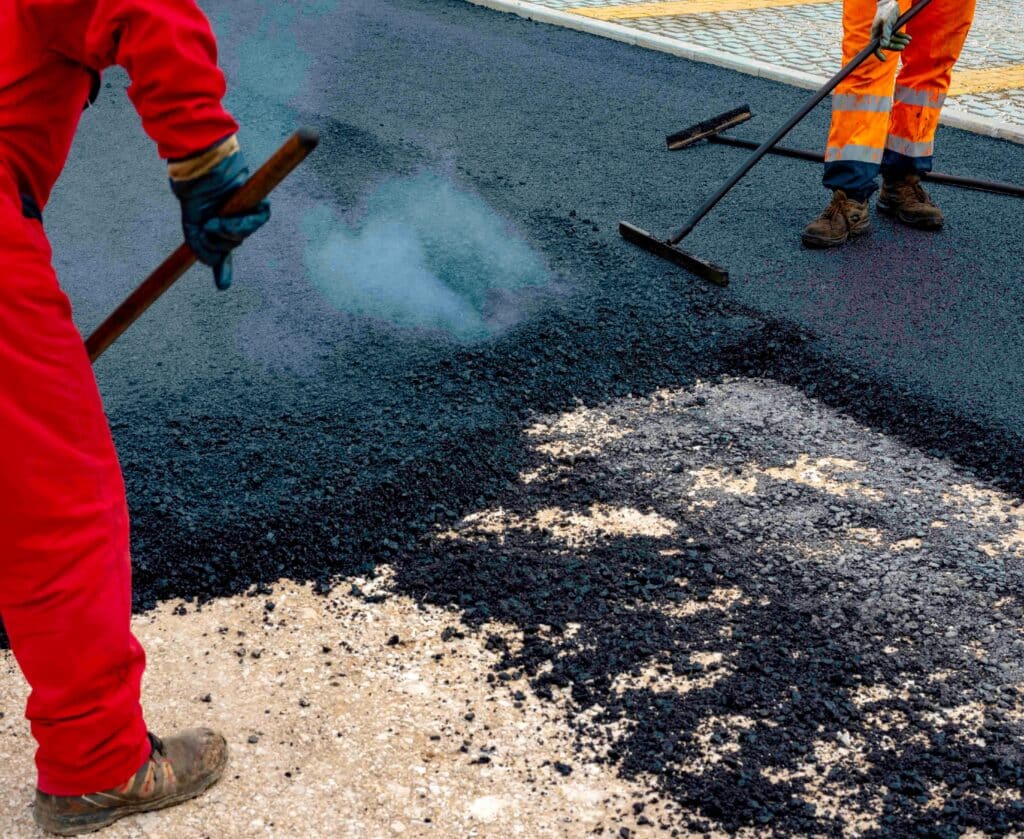Transform Your Residential property's Landscape with Hot Mix Asphalt Paving Excellence
Transform Your Residential property's Landscape with Hot Mix Asphalt Paving Excellence
Blog Article
Opening the Tricks of Warm Mix Asphalt Modern Technology
Exploring the depths of hot mix asphalt innovation discovers a world where precise solutions and meticulous processes merge to shape our roadways and framework. The blend of fillers, aggregates, and binders isn't simply a construction job yet a critical orchestration of durability and performance. As we peer right into the complex dance of elements, a tapestry of resilience and sustainability unravels. Yet what lies below this surface of asphaltic proficiency, and what tricks wait to be unveiled in the world of leading advancements?
Relevance of Hot Mix Asphalt
Warm Mix Asphalt plays an essential function in modern facilities growth due to its resilience and cost-effectiveness. As the most typically utilized paving material for roads, highways, and vehicle parking whole lots, Hot Mix Asphalt offers a range of advantages that add to its relevance in building and construction tasks.
The durability of Warm Mix Asphalt originates from its structure, that includes accumulations, binder, and filler products that are very carefully chosen and mixed to meet specific performance needs. This precise combination results in a versatile and strong pavement that can sustain constant use without significant wear and tear. Moreover, Warm Mix Asphalt is 100% recyclable, more improving its sustainability and environmental advantages. Overall, the importance of Warm Mix Asphalt in facilities development can not be underrated, as it continues to be a cornerstone of modern-day building practices.
Elements of Asphalt Mixes
The make-up of asphalt blends consists of thoroughly chosen accumulations, binder, and filler materials that are critical for achieving particular performance demands. Accumulations are the main part of asphalt blends, giving strength and stability. The binder, normally bitumen or asphalt concrete, holds the aggregates with each other and supplies adaptability and longevity to the mix.
The combination and percentage of these parts play a considerable duty in determining the high quality and performance of the asphalt mix. Engineers thoroughly develop the mix to satisfy particular demands, thinking about factors like web traffic quantity, climate problems, and sidewalk life-span. Correct option and harmonizing of aggregates, binder, and fillers are necessary for developing long lasting, resilient asphalt pavements.
Mixing and Manufacturing Strategies

As soon as the aggregates are selected, the binder, frequently asphalt cement, is added to bind the materials together. The binder's high quality and quantity considerably affect the mix's resistance, versatility, and strength to environmental aspects. In addition, fillers like moisturized lime or Rose city cement may be integrated to boost particular features of the asphalt mix, such as its workability or dampness resistance.
During production, the accumulations and binder are heated up, normally between 250-325 ° F(121-163 ° C ), to help with mixing and make certain appropriate finishing of the aggregates. The mixing process has to be complete to accomplish a homogeneous combination that promotes the desired efficiency qualities of the asphalt. Various strategies, such as batch mixing or drum blending, are used to accomplish top notch and consistent asphalt blends i thought about this for building and construction jobs.
Factors Affecting Asphalt Performance
Aspects affecting asphalt performance include an array of variables that influence the resilience, durability, and total quality of asphalt pavements. One crucial aspect is the high quality of products made use of in the asphalt mix.

Ecological conditions likewise affect asphalt performance. Temperature level variations, wetness seepage, and traffic tons can all influence the architectural integrity of the sidewalk. Layout considerations, such as sidewalk density and drainage, are necessary in ensuring the long-lasting efficiency of the asphalt sidewalk. By thoroughly considering these aspects, service providers and engineers can enhance asphalt performance and improve the life span of sidewalks.
Lasting Practices in Asphalt Modern Technology

Furthermore, the advancement of warm-mix asphalt (WMA) innovations has obtained grip in recent times. WMA permits the production and placement of asphalt blends at lower temperatures contrasted to standard hot-mix asphalt, leading to reduced power usage and greenhouse gas emissions. Furthermore, using porous asphalt mixes can aid alleviate stormwater runoff concerns by enabling water to infiltrate via the pavement and right into the ground, advertising natural water purification and charge procedures. By applying these sustainable practices, the asphalt market can add to developing an extra environmentally pleasant and resilient infrastructure network.
Conclusion
Finally, warm mix asphalt modern technology plays an essential function in contemporary infrastructure development due to its toughness and cost-effectiveness. By meticulously stabilizing parts, employing proper mixing techniques, and considering various factors, engineers can develop high-grade asphalt blends that withstand rush hour lots and harsh climate problems. Welcoming lasting methods, such as utilizing recycled materials and warm-mix technologies, better boosts the ecological kindness of asphalt innovation.
Mixing and manufacturing strategies in warm mix asphalt modern technology entail the exact combination and processing of accumulations, binder, and fillers to produce a high-performance and durable asphalt mix.Variables influencing asphalt efficiency incorporate a variety of variables that affect the sturdiness, durability, and overall useful reference top quality of asphalt pavements. Lasting techniques in asphalt innovation encompass numerous efforts aimed at minimizing the environmental influence of asphalt production and paving procedures. By integrating reclaimed asphalt sidewalk (RAP) and recycled asphalt shingles (RAS) right into new asphalt blends, the industry can significantly lower the usage of raw products and energy, while additionally reducing land fill waste.
WMA enables for the manufacturing and placement of asphalt blends at reduced temperatures contrasted to conventional hot-mix asphalt, resulting in lowered energy usage and greenhouse gas emissions.
Report this page